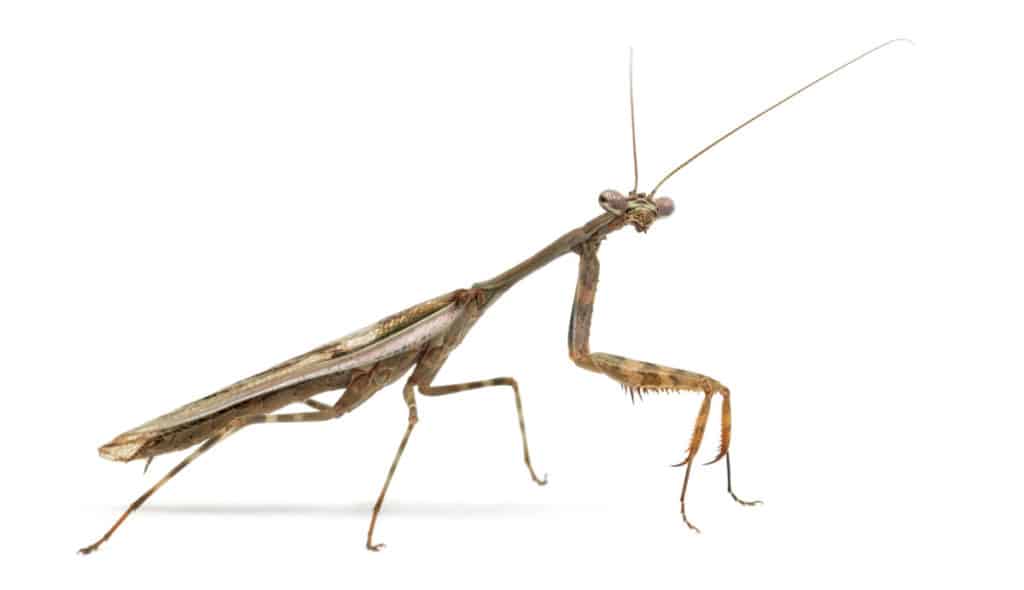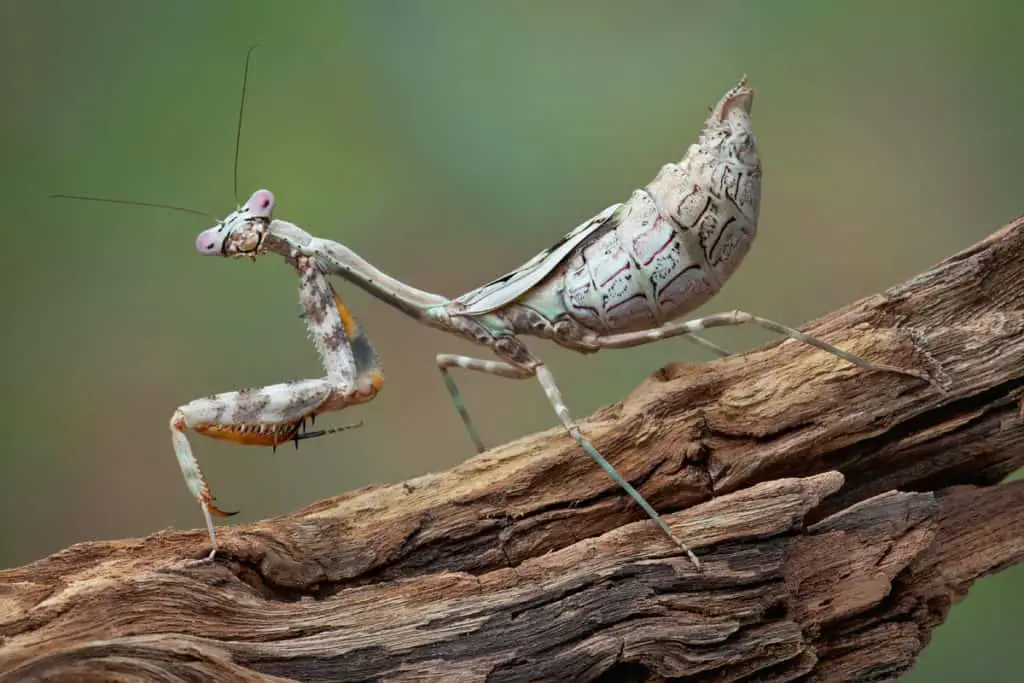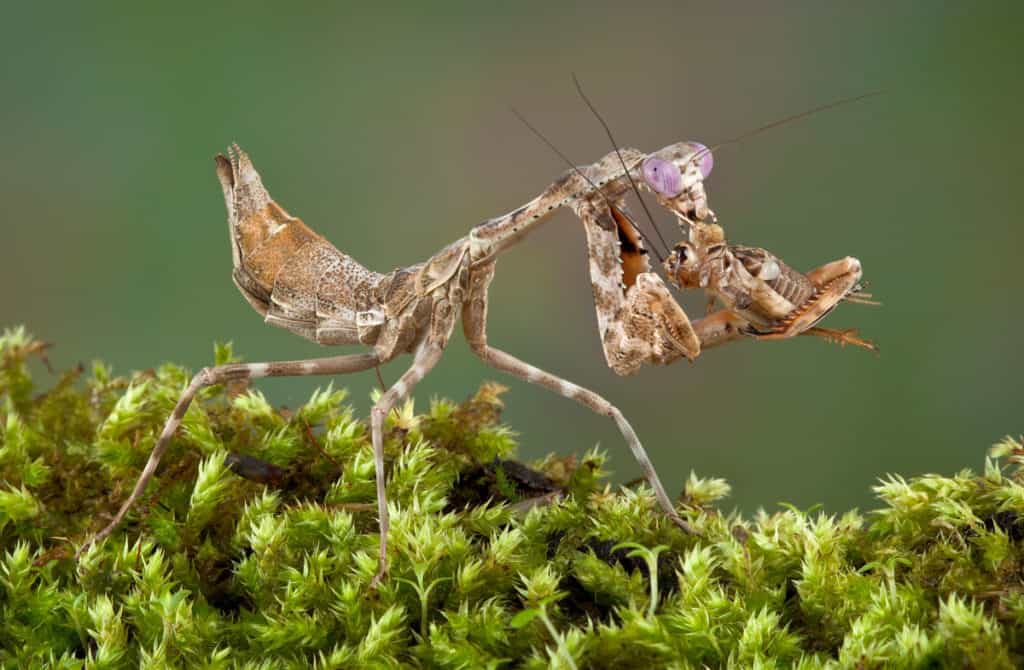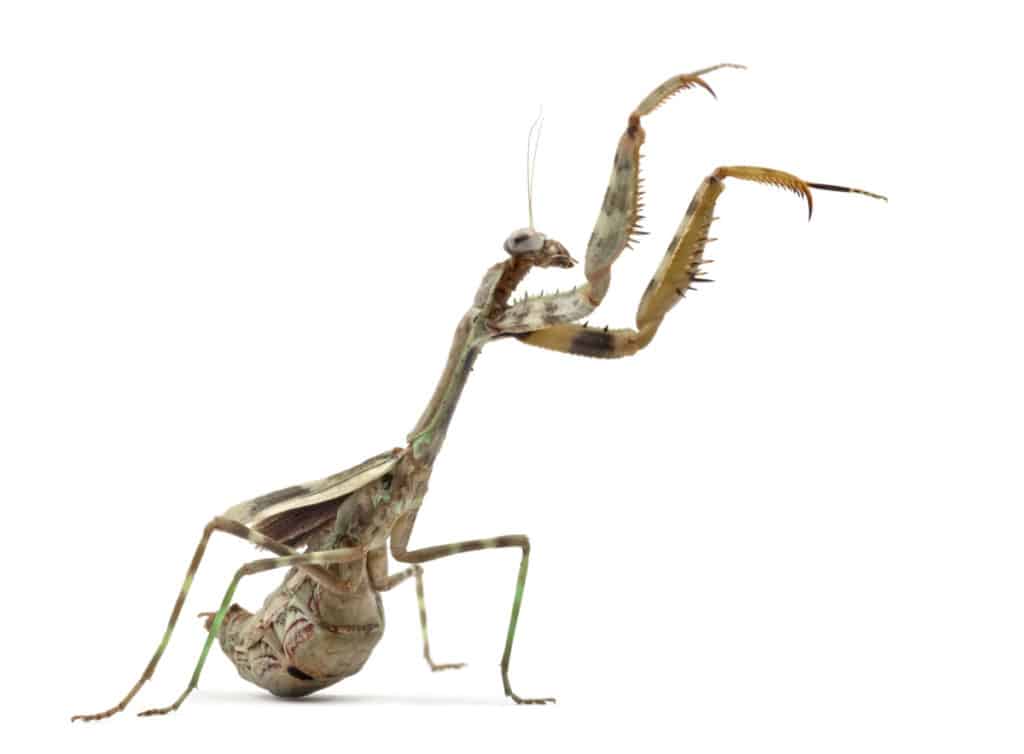Budwing mantises (also referred to as Parasphendale Agrionina or Parasphendale Affinis) are fascinating species native to East Africa but have since spread to the Americas, Asia, and Europe.
Their unique features include their color which ranges from grey to beige and their preference for pursuing prey. Females of the species do not typically grow any larger than 7cm while the maximum length for males is 3cm.

As far as praying mantises go, the Budwing Mantis certainly isn’t the biggest. That being said, these insects make up for what they lack in size with a giant appetite and unmatched levels of arthropod aggression. Like the rest of their kind, they aren’t especially social either since they aren’t averse to a nice slice of fellow mantid on the menu.
Budwings are not endangered and are one of the many mantis species which can be kept as pets and are easy to care for.
But who are these intrepid small-sized insects which have won a special place in the hearts of bug enthusiasts all over the globe?
How long do they live? What do they love to eat? Just how belligerent are they? How can you care for them as pets? Will they pose any danger (to you or your other pets)?
Right here on this page, you will find all you need to know about one of the most fascinating hexapod species on the planet.
Budwing Mantises: Origins, Lifecycle, and Habits
Budwing Mantis: Origins
While budwings call the sunny Kenya home, they can be also found in Europe, Japan, and the United States, thanks to arthropod enthusiasts who love to keep them as pets.
As far as little companions go, they don’t live all that long with a lifespan of about a year or slightly longer with loads of care. And yet, they have been known to intrigue and delight their owners and are a rather popular choice of the domestic hexapod.
Budwing Mantis: Lifecycle
Budwings, like the rest of their huge family, tend to have a unique lifecycle.
It all starts out in the fall when a female finds herself a suitable mate, following which she will lay a maximum of 400 eggs.
The female budwing protects them in a foamy case known as an ootheca and places them in a suitable spot, on a branch, for example.
The mother-to-be dies a short while afterward.
Budwing junior emerge from its egg case about one month later (depending on the weather and climate) looking like a little adult with an appetite to match. Anything within its vicinity is fair game, including its own siblings.
And yet, raging appetite notwithstanding, the little mantid is just in as much danger from other vicious predators lurking around such as spiders, wasps, birds, frogs, and lizards.
However, five molts later when it has attained full adulthood (a process which should take about six months), the tiny budwing will morph into a miniature killing machine ready to take on virtually anything in sight.
There is no pupal or larval stage for these remarkable little guys and scientific experts refer to their lifecycle as being incomplete as a result.
Budwing Mantis: Habits
Unlike several of their other relatives which prefer to play a waiting game when hunting prey, budwings prefer a more proactive approach. As a result, they tend to chase down any unfortunate bug or creature which they feel looks especially delectable.
They are also believed to be one of the few mantid species which will tuck into lifeless prey. A pet owner noted that his pet budwing actually helped itself to a dead goldfish floating in a fishbowl and tucked right in.
This species also has a reputation for being extremely aggressive (its females at least), and never backing down from a fight.
Its males on the other hand are by no means as tough and have no compunction about taking off in the face of danger, literally and figuratively (since they can fly).
How To Identify A Budwing Mantis
Unlike most mantids which are leafy green or even brown in color, budwings come in shades of grey and brown with darker specks. This almost makes them seem like they’re wearing combat fatigues.

As is the case with all their other relatives, females are significantly larger than their male counterparts.
The former also has stubby wings while the latter has wings that are larger than their bodies enabling them to fly.
It is also worth noting that males have a longer abdomen with eight segments compared to females who only have six.
Budwing Mantis Diet
One of the main things a budwing is most concerned about is maintaining a full stomach. Therefore, virtually nothing is off-limits: siblings, mates (in the case of a female), and not even dead insects or animals. Any creature small enough to be overpowered and munched on is fair game as far as it’s concerned: those of the soft-bodied variety, are a particular favorite.
As a matter of fact, this species is capable of gorging itself to the point of illness.
Such tendencies mean that pet owners must maintain the perfect balancing act of keeping their mantid charges well-fed while preventing overfeeding.

Some of their favorite food includes crickets, cockroaches, fruit flies, locusts, mealworms, and waxworms.
A distended abdomen is a sure sign that your pet mantid has helped itself to one fruit fly too many. This means you will need to place it on a crash diet for about a couple of days during which no grub will go near those mandibles.
Failure to do so could result in serious problems for your pet. However, one instance when you will notice a remarkable drop in your mantid’s appetite is when it’s about to molt. It will abstain from food for about 48 hours before the process takes place.
No food should be introduced during this period, and you will need to wait an additional 48 hours to allow its new exoskeleton to harden. This is due to the fact that arthropods are especially vulnerable during the molting process and your pet may be susceptible to injury from one of the critters it’s meant to munch on.
We have a whole article on the diets of praying mantis if you are interested. The article is called, What Do Praying Mantis Eat? (With Video Hunting A Fish)
Budwing Mantis Temperament
Certain pets simply cannot get by without having another member of their species close by for companionship and comfort.
However, when it comes to mantids, experts recommend keeping them in different enclosures due to their natural aggression.

That said, there are actually certain species that are known to tolerate the company of their kin.
Budwings which are naturally cantankerous and fond of life on the prowl, do not belong to that category, but to the tetchy, confrontational majority.
Hence following the usual practice of keeping them in separate enclosures as mentioned above, is highly recommended, particularly since failing to do so could result in your going from having two pets to just one, or even none at all.
Caring For A Pet Budwing Mantis
Choosing A Pet Budwing
Most mantid retailers tend to provide the following options: ootheca (the casing in which praying mantises lay their eggs), nymphs, and adults.
An egg case may be suitable if you intend to breed mantises. If not, a nymph will be ideal due to the fact that its life has only just begun.
An adult, on the other hand, may not be a good idea if you are unable to tell how old one is and how many molts it has had, since it may have a short while to live.
Ambient Temperature
These mantids hail from a warm climate with loads of sunshine and just the right amount of moisture in the air. As a result, your pet will require a bit of warmth (between 25 – 29 degrees) and some spraying (more to come on that later).
Experts recommend the use of heating mats placed above the enclosure, with a thermostat so you can monitor temperatures and ensure your pet mantid enjoys the warmth it needs.
Suitable Accommodation
You’ll also have to ensure that suitable accommodation is arranged for your resident hexapod. This means ensuring its quarters are the right size — if it’s too large the mantid might not be able to spot that fruit fly breakfast or that mealworm snack you’ve left it.
Experts recommend an enclosure that is twice as high as the pet is and thrice as long. They also recommend cross-ventilating it to ensure your little guest gets to enjoy loads of fresh air just like it would outdoors.
In terms of material, either glass or acrylic will do nicely, since budwings are natural little climbers that will have no problem climbing walls made from these materials.
Your pet will need a spot where it can sit pretty following a molt until its exoskeleton can harden nicely again. So, a nice little twig or stick close to the top of the enclosure to serve as a support beam, or a mesh ceiling for them to hang onto, particularly during molting, will be necessary.
Moisture is important for aiding in the molting process, keeping your pet comfy, and enabling it to drink. Experts recommend spraying twice each day.
(Mantids do not like being sprayed and special care should be taken to direct the blast away from your budwing to avoid getting on its bad side.)
Experts also recommend placing paper towels or soil at the bottom of the enclosure to trap moisture and maintain a suitable environment for your mantid. You may also provide rocks and real or fake plants, or twigs for it to clamber over as well.
It is also important to keep your pet’s enclosure clean to avoid any leftover food or frass causing mold or attracting bacteria that may be fatal to your pet.
Interacting With Your Pet Budwing Mantis
Like most arthropods, budwings are rather fragile, and hence handling them requires special care. Experts recommend holding out your hand to your pet and letting it wander onto your fingers. Attempting to grasp it may cause injury, or make it rather defensive — resulting in a little jab from its front leg spikes.
Thankfully, those little pinpricks aren’t poisonous or particularly harmful, other than the mild discomfort they may cause, and you will simply need to wash the injury which should heal promptly.
Care must be taken to observe your budwing so you can know when it’s undergoing molting: during this period you will need to avoid contact with it for about one or two days before attempting to handle it again.
Special care must also be taken to keep it out of the reach of resident canines, felines (and even avians). These pets can be especially curious and will lack the delicacy required to handle a mantid, (as well as the restraint required to deal with a resulting jab).
But what if your golden retriever or Scottish fold does get a tiny ‘sting’ or (worst case scenario) actually decides to snack on your pet mantid?
A defensive little stab from those front legs will not harm your pet, and all you will need to do is clean the injury. If the naughty furball has chewed your mantid, there will be no risk of poisoning. However, a trip to the vet might be required just to forestall any resulting consequences such as a stomach upset, for example.
Breeding Budwing Mantis
Do you love these little critters and are you capable of caring for loads of them?
You might be able to breed them. In which case you will need to set the female mantid on a carefully monitored date with her male counterpart. The event should preferably take place about a month following the female’s final molt, according to experts. Failure to pay close attention to proceedings may result in the male ending up as the main course on the menu.
Experts also recommend ensuring the female budwing shows up well-fed to forestall any temptation to snack on her mate.
What should you do if the couple doesn’t seem to be getting along?
Simply withdraw the male, and have him try again.
What should you do if it all goes as planned?
Monitor it all closely so that you can withdraw the male in time to prevent your female from changing her mind and deciding to tuck her mandibles into him.
The Wrap Up
They come in shades of grey and brown, with a little hint of color and as far as size is concerned, are somewhat small for mantids.
But miniature size notwithstanding, they’re as fierce as they come and in a departure from typical mantid behavior will hunt down their prey rather than wait for it to come to them.
They also love to eat, (family and mates included) and are pretty much unaware of when to stop.
They don’t live that long, slightly over a year at the most.
And yet in spite of stiff competition from fellow arthropods all over the globe, these diminutive mantids have become a firm favorite among insect enthusiasts, proof of just how remarkable and intriguing they truly are.
If you would like to know more about some other species of praying mantis or maybe you are thinking of getting a pet praying mantis, then check out these other articles we have written:
Are White Praying Mantises Rare?
The Giant Asian Mantis: Your Complete Guide
The Devil’s Flower Mantis: Your Complete Guide
The Spiny Flower Mantis: Your Complete Guide
The Ghost Mantis: Your Complete Guide
Sources
https://www.healthline.com/health/praying-mantis-bite#summary
https://www.ourbreathingplanet.com/budwing-mantis/
https://pethelpful.com/reptiles-amphibians/praying-mantis-care
